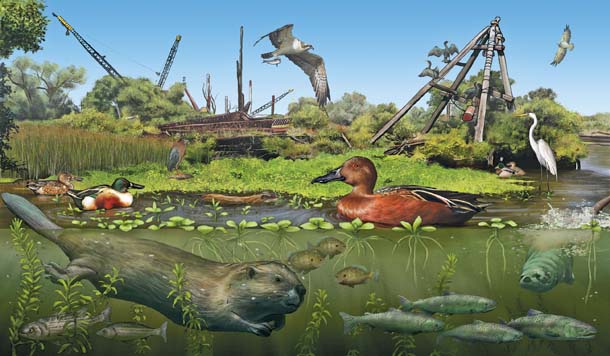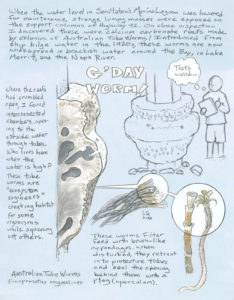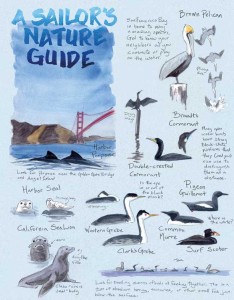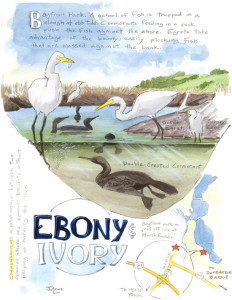When we decided to commission an original illustration for our January feature about Big Break Regional Shoreline, I did what I often do in these situations: I contacted Ann Caudle, who runs the scientific illustration program at Cal State Monterey. She suggested Logan Parsons, a freelance illustrator based in Pacific Grove.
She created the illustration above based on expert input from Mike Moran, the lead naturalist at Big Break Regional Shoreline, near Oakley. The end result is a composite view that portrays the remarkable diversity of birds, mammals, and fish in this part of the Sacramento-San Joquin Delta.
“It’s an idealized view,” says Parsons. “All of these animals and plants exist here, but not at the same time. These are my favorite types of illustration.”

Parsons spends a lot time in the field sketching wildlife, but illustrations like this one happen mostly in the studio. “This is all done in Photoshop, sort of like making a collage,” she explains. “I used a photo of the site and then gave it an underwater view and placed all the animals that I could. So then I have this collage. I printed out all the animals — I call them frankenanimals — and I traced them on tracing paper, and then scanned them back in. And then I placed those back in and voila I have a drawing.”
“The sketch took at least half the time if not more. From there, in Photoshop, each animal is on its own layer. You work in layers, sort of like painting in watercolors, you are building things up in that same way. For instance, on the cinnamon teal, that was a whole group of layers. First solid brown, and then sort of stroke in the other colors. And then with any of those animals, I can take them out with a click of the button.”
But the results she gets in the studio depend a lot on the time she spends in the field, just not in the way one might expect. “I see field sketching as sort of an entirely different activity. I enjoy field sketching more not to create a pretty picture but to experience observing something really carefully. It’s like meditation. It helps improve your illustrating but not in a direct way. It percolates down and makes me a better illustrator.”
Parsons has wanted to be a nature illustrator since she in high school. She participated in an after-school open art program in Monterey called the Youth Art Collective, where she met Mathew Squillante, who was working at the Monterey Bay Aquarium.
Squillante saw her work and told her she really needed to meet Ann Caudle, who runs the program from which Squillante graduated. (He happens to have done one of our first all-digital illustrations, of Bay shrimp, and many other illustrators we’ve worked with have graduated from Caudle’s program, including Jack Laws, Tim Gunther, and Amadeo Bachar.)
She went off to college in Washington State to study biology only because the illustration program requires a bachelor’s degree. Once that was done, she went straight back to illustration and is now teaching at her alma mater in addition to freelance work.
“My last big project was last April and May I worked on illustrating an article in The Scientist magazine, and I got to paint a cutaway of a naked mole rat burrow, and coming up I am going to be doing a three-foot-by-four-foot painting of Point Lobos for a friend. It’s fun to do fine art painting when I get the chance.”
See more of Logan Parsons’s work at parsonsillustration.com.





